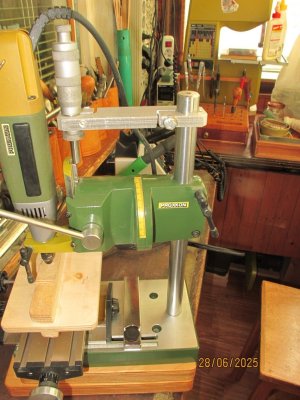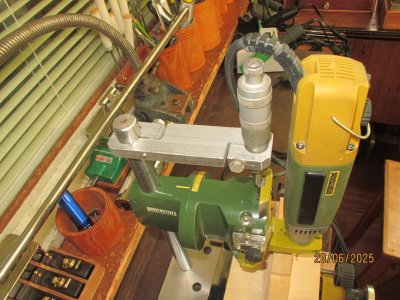I’m thinking about adding a bench drill press to my modeling tools but not sure which one’s a good, budget-friendly option. I also do some DIY woodworking at home, so it needs to handle both. A friend recommended Porter-Cable, but it looks like they’re not being made anymore. Anyone got experience with other brands or suggestions for gear available locally in the US?
-

Win a Free Custom Engraved Brass Coin!!!
As a way to introduce our brass coins to the community, we will raffle off a free coin during the month of August. Follow link ABOVE for instructions for entering.
You are using an out of date browser. It may not display this or other websites correctly.
You should upgrade or use an alternative browser.
You should upgrade or use an alternative browser.
There are several reputable brands to consider, but what about the budget and specs? Do you need a basic drill press or are you willing to have advanced features?I’m thinking about adding a bench drill press to my modeling tools but not sure which one’s a good, budget-friendly option. I also do some DIY woodworking at home, so it needs to handle both. A friend recommended Porter-Cable, but it looks like they’re not being made anymore. Anyone got experience with other brands or suggestions for gear available locally in the US?
Hi Jim,
Thanks for asking! Right now, I’m focused on getting a drill press that’s well-suited for detailed, precise work on ship models like the Santísima Trinidad, which is on my project list. So precision and reliability for fine craftsmanship are key at this stage.
For now, a solid basic model that offers good control and accuracy will do the job perfectly. That said, I’m definitely open to upgrading to more advanced models with extra features down the line as my project grows and requires more versatility.
Basically, I want to get one that will last for years and avoid having to replace it again in just a few.
Thanks for asking! Right now, I’m focused on getting a drill press that’s well-suited for detailed, precise work on ship models like the Santísima Trinidad, which is on my project list. So precision and reliability for fine craftsmanship are key at this stage.
For now, a solid basic model that offers good control and accuracy will do the job perfectly. That said, I’m definitely open to upgrading to more advanced models with extra features down the line as my project grows and requires more versatility.
Basically, I want to get one that will last for years and avoid having to replace it again in just a few.
- Joined
- Jan 25, 2023
- Messages
- 540
- Points
- 308

I have two versions, but I can't recommend them under the budget friendly clause. However, because of their nature as doing more than just drilling, they may still be viable to you in the long run. The first is a mini mill. These are a workhorse in building wooden ship models from scratch. Drilling is the easiest thing they do and they easily knock that job out of the park. They are a must have for advanced modeling.
The second is a Foredom rotary tool with a desktop drill press adapter. I think it goes without saying how indispensable a rotary tool is and Foredom are amongst the best. The drill press attachment clamps or bolts to your desk and your handpiece clamps into it. The handpiece itself has a very high precision built into it and the press uses that to make very accurate and repeatable holes.
So, yeah, I know these aren't the answer you are looking for right now, but maybe something to think about long term.
The second is a Foredom rotary tool with a desktop drill press adapter. I think it goes without saying how indispensable a rotary tool is and Foredom are amongst the best. The drill press attachment clamps or bolts to your desk and your handpiece clamps into it. The handpiece itself has a very high precision built into it and the press uses that to make very accurate and repeatable holes.
So, yeah, I know these aren't the answer you are looking for right now, but maybe something to think about long term.
Immediately, I come up with Proxxon TBM‑115 Precision Bench Drill Press
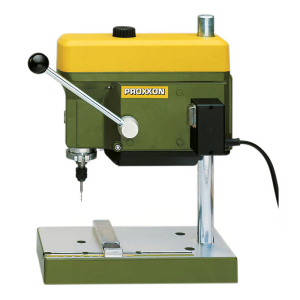
A specialty micro drill press for highly precise work. Belt-driven, three-speed (1800/4700/8500 RPM) with precision collets down to 0.5 mm—perfect for drilling mast holes, tiny fittings, etc., at a higher price point (~$230 Amazon).
If you own one of the Proxxon rotary tools already, you may look for a stand drill: Proxxon 28600 Micromot Drill Stand MB 200. Then, you can attach a rotary tool and use it as a drill press.
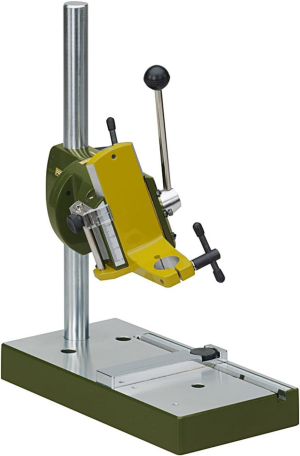

A specialty micro drill press for highly precise work. Belt-driven, three-speed (1800/4700/8500 RPM) with precision collets down to 0.5 mm—perfect for drilling mast holes, tiny fittings, etc., at a higher price point (~$230 Amazon).
If you own one of the Proxxon rotary tools already, you may look for a stand drill: Proxxon 28600 Micromot Drill Stand MB 200. Then, you can attach a rotary tool and use it as a drill press.

Jim, Thanks for taking the time to read my help request and provide a suggestion.
Thanks again! Actually, I was originally looking for a mini drill—something compact and precise for ship modeling—but I wasn’t sure how useful it’d be for other small woodworking projects around the house. Nothing too heavy-duty, just shelves, closets, and the occasional DIY fix.I have two versions, but I can't recommend them under the budget friendly clause. However, because of their nature as doing more than just drilling, they may still be viable to you in the long run. The first is a mini mill. These are a workhorse in building wooden ship models from scratch. Drilling is the easiest thing they do and they easily knock that job out of the park. They are a must have for advanced modeling.
The second is a Foredom rotary tool with a desktop drill press adapter. I think it goes without saying how indispensable a rotary tool is and Foredom are amongst the best. The drill press attachment clamps or bolts to your desk and your handpiece clamps into it. The handpiece itself has a very high precision built into it and the press uses that to make very accurate and repeatable holes.
So, yeah, I know these aren't the answer you are looking for right now, but maybe something to think about long term.
As for the Foredom idea, funny enough—I’ve got a mini table setup from SakerPlus (a birthday gift from my daughters, still sitting in the box until next week). It includes a rotary tool, so I’m curious to see how it stacks up once I put it to use. It might not be Foredom-level, but for where I’m at right now, it could be a good place to start.
Appreciate your insight—it’s definitely helping me think longer term as I build up my workshop!
- Joined
- Jan 25, 2023
- Messages
- 540
- Points
- 308

Carlos, I googled the SakerPlus and while I am not usually a fan of these types of multi tool, I think the flexi-shaft might be a viable option for you. It might even work with the Proxxon drill press attachment Jim mentions above or the Foredom one I mentioned. You'll have to check the specs and see if either of them are compatible, or could be made compatible with a little reworking. The one piece of advice I might offer, though, would be to please take the saw blade off when you are using the rotary tool, leaving it on is just begging to hurt yourself or destroy whatever you're working on.Thanks again! Actually, I was originally looking for a mini drill—something compact and precise for ship modeling—but I wasn’t sure how useful it’d be for other small woodworking projects around the house. Nothing too heavy-duty, just shelves, closets, and the occasional DIY fix.
As for the Foredom idea, funny enough—I’ve got a mini table setup from SakerPlus (a birthday gift from my daughters, still sitting in the box until next week). It includes a rotary tool, so I’m curious to see how it stacks up once I put it to use. It might not be Foredom-level, but for where I’m at right now, it could be a good place to start.
Appreciate your insight—it’s definitely helping me think longer term as I build up my workshop!
Thanks for the heads-up — that’s solid advice. I wasn’t sure how compatible the SakerPlus flexi-shaft might be with the Foredom or Proxxon attachments, but I’ll definitely check the specs more closely now.Carlos, I googled the SakerPlus and while I am not usually a fan of these types of multi tool, I think the flexi-shaft might be a viable option for you. It might even work with the Proxxon drill press attachment Jim mentions above or the Foredom one I mentioned. You'll have to check the specs and see if either of them are compatible, or could be made compatible with a little reworking. The one piece of advice I might offer, though, would be to please take the saw blade off when you are using the rotary tool, leaving it on is just begging to hurt yourself or destroy whatever you're working on.
And yes — message received loud and clear about the saw blade! After years in the chemical industry with a strong focus on safety leadership, I know how easy it is for small oversights to lead to real problems. I’ll make sure to remove the blade when switching to rotary use — and I’ll probably add a small warning label as a backup to make sure it’s never forgotten. Really appreciate the reminder!
- Joined
- Jun 29, 2024
- Messages
- 1,420
- Points
- 393

My drill press was bought by me in about 1972. It has given me reliable service ever since and it gets by far the most usage of any power tool in my shop. It it is all cast and machined steel. The only plastic is on the knobs. It’s all that I need.
I don’t understand “advanced” features. A drill press only needs to do two things; rotate the drill and move it up and down. My drill press uses belts on stepped pulleys to change speeds, but I haven’t found the need to do this for many years. I would avoid electronic speed control. An auxiliary Chuck that fits into my drill press cuck allows me to drill with tiny wire sized drill bits.
If I needed to replace my drill press my choices would be in order of preference:
1. A well cared for but used Delta unit.
2. A new Delta, Grizzly, Jet, or Rikon unit.
3. A drill press sold by one of the woodworking supply houses; Woodcraft, Rockler, etc.
4. One of the store brands sold by major home improvement stores.
Larger is better. The key dimension is the distance between the center of the spindle and the column. My 6” unit is marginal. If I needed to replace it I would buy an 12” unit. I would NOT buy any drill press marketed to hobbyists like the Proxxon unit posted above.
Roger
I don’t understand “advanced” features. A drill press only needs to do two things; rotate the drill and move it up and down. My drill press uses belts on stepped pulleys to change speeds, but I haven’t found the need to do this for many years. I would avoid electronic speed control. An auxiliary Chuck that fits into my drill press cuck allows me to drill with tiny wire sized drill bits.
If I needed to replace my drill press my choices would be in order of preference:
1. A well cared for but used Delta unit.
2. A new Delta, Grizzly, Jet, or Rikon unit.
3. A drill press sold by one of the woodworking supply houses; Woodcraft, Rockler, etc.
4. One of the store brands sold by major home improvement stores.
Larger is better. The key dimension is the distance between the center of the spindle and the column. My 6” unit is marginal. If I needed to replace it I would buy an 12” unit. I would NOT buy any drill press marketed to hobbyists like the Proxxon unit posted above.
Roger
Last edited:
Roger,My drill press was bought by me in about 1972. It has given me reliable service ever since and it gets by far the most usage of any power tool in my shop. It it is all cast and machined steel. The only plastic is on the knobs. It’s all that I need.
I don’t understand “advanced” features. A drill press only needs to do two things; rotate the drill and move it up and down. My drill press uses belts on stepped pulleys to change speeds, but I haven’t found the need to do this for many years. I would avoid electronic speed control. An auxiliary Chuck that fits into my drill press cuck allows me to drill with tiny wire sized drill bits.
If I needed to replace my drill press my choices would be in order of preference:
1. A well cared for but used Delta unit.
2. A new Delta, Grizzly, Jet, or Rikon unit.
3. A drill press sold by one of the woodworking supply houses; Woodcraft, Rockler, etc.
4. One of the store brands sold by major home improvement stores.
Larger is better. The key dimension is the distance between the center of the spindle and the column. My 6” unit is marginal. If I needed to replace it I would buy an 12” unit. I would NOT buy any drill press marketed to hobbyists like the Proxxon unit posted above.
Roger
Thanks for the detailed feedback — much appreciated. I’ll be doing some window shopping at Home Depot and Lowe’s to see what’s available within budget (always a budget concern!). For now, I’ll wait and see how things go with my new mini table rotary tool before making any big drill press decisions.
Appreciate you taking the time to share your experience — definitely helpful as I weigh my options.
The Proxxon drill press looks nice. I have a Proxxon mill and with my limited shop space I can't justify having both that and a drill press; however, I will say that having a dedicated drill press is nice because some jobs call for a lower RPM than the mill can provide.
Harbor Freight has a small, affordable drill press that works pretty well, although like most other drill presses above hobbyist class, it needs a collet or other chuck adapter to use really small bits. Taking the top off a pin vice works well enough for that.
Harbor Freight has a small, affordable drill press that works pretty well, although like most other drill presses above hobbyist class, it needs a collet or other chuck adapter to use really small bits. Taking the top off a pin vice works well enough for that.
- Joined
- Jun 29, 2024
- Messages
- 1,420
- Points
- 393

Yes, budget is always a concern. In 1972 I believe that my drill press cost $300. I was two years into a job where my starting salary was $12,000 per year and my wife was teaching school making half that. 50 years later it was a good investment.
Roger
Roger
Thanks for the data, including harbor Freights in my window shopping list !!The Proxxon drill press looks nice. I have a Proxxon mill and with my limited shop space I can't justify having both that and a drill press; however, I will say that having a dedicated drill press is nice because some jobs call for a lower RPM than the mill can provide.
Harbor Freight has a small, affordable drill press that works pretty well, although like most other drill presses above hobbyist class, it needs a collet or other chuck adapter to use really small bits. Taking the top off a pin vice works well enough for that.
- Joined
- Apr 12, 2025
- Messages
- 282
- Points
- 158

Bear in mind. A lot of your cheap, sloppy drill presses can be tightened up quite a bit by packing a bit of grease into every nook and cranny between parts that move, 'especially' the Z axis movement and the spindle where your chuck spins. Oil won't do it. You need thick 'grease'!
Larger is better. The key dimension is the distance between the center of the spindle and the column. My 6” unit is marginal. If I needed to replace it I would buy an 12” unit. I would NOT buy any drill press marketed to hobbyists like the Proxxon unit posted above.
At the risk of catching a lot of flack, I have to agree with Roger. I would be very careful about buying anything marketed to hobbyists, regardless of how popular it may be. I think there are much better options, in terms of features, quality, and price, than Proxxon or the stuff Model Expo sells. Such products are of marginal quality and generally exorbitant cost. I'll add, too, that I would avoid most electrically powered machinery manufactured in China if at all possible. If you have to buy a Chinese-made machine, buy it from one of the top-end retailers such as Grizzly or Little Machine Shop, because, although they may be a bit more expensive for the "same" machine, you are paying for a better machine made to a higher level of quality control than the less expensive versions of the same machine sold by others at lower prices. Do not buy any electrically driven machine tool from Harbor Freight. ("Horror Fright.") Do not buy any machine tool you expect to use for high-tolerance work (i.e. ship modeling) from a "Big Box" DIY store like Home Depot ("Home Despot,") Lowe's, or Menard's, etc. The least expensive tool is always the one you only have to buy once.
As mentioned above, the ubiquitous "mini-mill" made, I believe, by Sieg in China, purchased from a top-end retailer, is a nice little mini-milling machine but it has its limitations as a drill press:
1. With shipping, it will set you back about $1,250 USD and that does not include tooling, which will run you probably $300 USD to $600 USD for basic tooling alone. Unless you plan to do a lot of milling of small pieces, that's a lot of money if what you intend to primarily use it for is a drill press.
2. You will only have four inches between the mouth of the chuck and the table, so considering the length of a drill bit, you're only going to be able to drill workpieces less than two or three inches high. This is the major limitation of this tool's utility as a drill press.
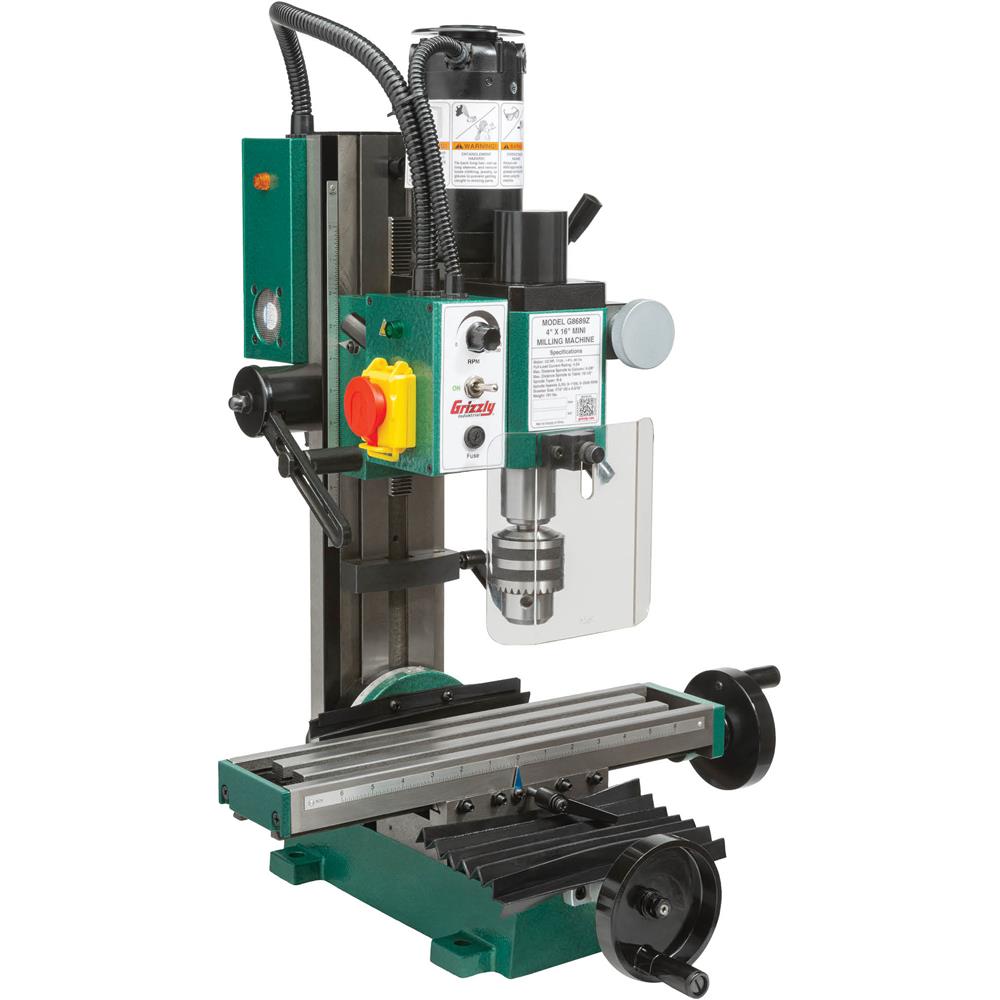
Grizzly G8689Z - 4" x 16" Mini Milling Machine - Grizzly Industrial, Inc.
<h1>G8689Z 4" x 16" Mini Milling Machine</h1> <h2>An ideal benchtop milling machine for the home hobbyist.</h2> <p>The G8689Z 4" x 16" Mini Milling Machine can power through up to 1/2" drilling, 1/2" end mills, and 1" facing for the consistent results you need.</p> <p>This benchtop mill features...
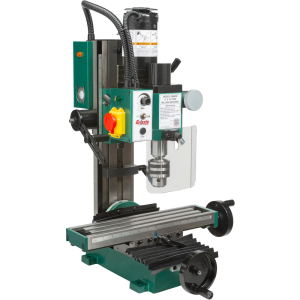
Grizzly does sell a nice benchtop "mill/drill" which does have seven and a half inches of clearance between the chuck and tabletop, hence it's being classed as a combination milling machine and drill press, but that puppy will set you back about $3,750 USD!
See: https://www.grizzly.com/products/grizzly-7-x-27-1-hp-mill-drill-w-stand-dro/g0759?msclkid=c97134c0001216c852325c9f31167791&utm_source=bing&utm_medium=cpc&utm_campaign=[ADL] [PLA] [Shopping] - All Products&utm_term=4586063006215776&utm_content=All Products&adlclid=c97134c0001216c852325c9f31167791
If you wish to acquire a "bench drill press" for general woodworking, etc., drill press use, you should get a full-size bench top drill press as Roger describes. If you wish to acquire a drill press for high-tolerance miniature work, you will need a specialized drill press for miniature work, often called a "sensitive drill press."
A "sensitive drill press" is a drill press designed for use on close tolerance limit small diameter drilling. They are used primarily by watch, camera, scientific instrument makers and the like. Distinctively, "sensitive drill presses" provide very sensitive tactile feedback through the control lever or rack and pinion knob so the operator can feel the bit's progress when drilling very small holes. These are made by a limited number of manufacturers and you won't find one at Harbor Freight or your local Big Box DIY store, but they are really what a serious miniaturist would want for small work in its size range if price were no object. Unfortunately, these gems go for $1,500 USD on up retail, although you might be able to find a used one on eBay for $400 USD on up, if you're lucky. I wouldn't advise anybody dropping real money on a used one of these unless you could put a DTI on the quill and check it for any runout first. Sensitive drill presses are not suitable for doing any sort of ordinary drilling above about a quarter of an inch. Their chucks are made to hold very small bits and alone often run a hundred bucks or more.
The big advantage sensitive drill presses have over larger ones is that the former are designed to have little or no runout and, hence, not be inclined to break tiny drill bits. A tiny drill bit, even in a good chuck, will likely snap if there is any "wobble" when drilling.
Sensitive drill presses are explained in greater detail in this video:
A compromise option for a sensitive drill press is the Unimat SL or DB2000 combination lathe, drill press and milling machine, and with attachments, also a micro-table saw and lots more. Unfortunately, these are no longer manufactured, so you are limited to buying a used one, which may or may not be in good shape. The tooling also has to be sourced on the used market for sometimes outrageous prices owing to their rarity. While once the quintessential modeling lathe and drill/mill, they've become a cult collector's item these days and getting one in good shape with a good tooling selection can run $750 USD on up into the four figures. As they were made in Austria, there are a lot more of them still available on the used market in Europe and the UK, so those guys are luckier than we are here in the U.S.A. The advantage of the Unimat is that you get a good micro-lathe as well. They are an acquired taste, I suppose, but if you come across one that's being sold under the going price, you'd do well to grab it.
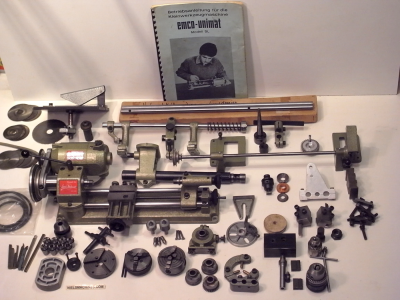
Unimat SL set up as a drill press or milling machine:
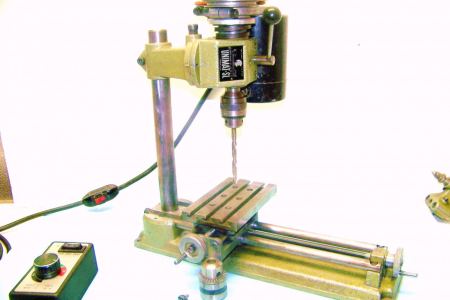
These days, the Sherline Products Company of Vista, California, makes a beautiful line of mini-lathes and milling machines. If I were able to afford to buy a brand new mini-lathe or milling machine, I'd be buying one of theirs. They are pricy, though. See: https://www.sherline.com/
In my opinion, while they have their uses and are certainly worth having, rotary tools such as the Dremel line and others are definitely not suitable for drilling with small bits. Freehand, the slightest shake of the hand will cause a small bit to break and if used freehand, they are only as accurate as your hand is. There are a number of drill press stands made to hold a Dremel MotoTool, but most are pathetically unstable, the Dremel brand's own version being perhaps the worst of the bunch if consumer reviews are any indication. The best of these rotary tool holding drill presses is the line (which includes a wood-turning lathe, a mill, and a table saw option) made by Vanda-Lay Industries of Running Springs, California. (See: https://vanda-layindustries.com/) Their products are CNC-machined of aluminum plate and stainless steel and are of high quality. Their accuracy is acceptable, given their relatively affordable price point and their intended use for miniature modeling. They do not, however, rise to the level that would be desired by an exacting watchmaker or miniature machinist. Nonetheless, I would consider them a good choice for a modeler on a budget who wants such machines for modeling use.
That said, the major drawback to the Vanda-Lay system is its reliance on the Dremel MotoTool as a power source. The Dremels and "micro-motor" rotary tools rely on speed (RPM's) rather than torque (twisting force) to get the job done. If you want to slow them down for exacting work, they tend to stall out because they lack the torque necessary. At high speeds, they are much too aggressive to control for fine work, such as micro-carving. A far, far better option used by most all professionals is a flex shaft tool with interchangeable handpieces. The industry standard is the Foredom flex shaft machine. There are now Chinese made copies on the market which I cannot comment upon, but I love my genuine Foredom and it certainly is an example of getting what you pay for. (I bought mine with two handpieces, one with a chuck and one for collets, used for $75 USD years ago.) If one has any intention of using a tool to any extent, it is always the best practice to buy the best one you can possibly afford. Foredom does make a drill press stand for its handpieces, but from the looks of it, for the price I wasn't particularly impressed. I spoke with Vanda-Lay some time ago and they told me they'd be happy to cut me up a Vanda-Lay holder for the 1" diameter Foredom handpieces so that their machines would run using Foredom's high-torque flex shaft motor. (It's easy enough to make one yourself out of a hunk of aluminum plate for free, so I didn't order one. That job is still on my bucket list, though, since I have better micro-drilling machinery for the purpose these days.)
Vanda-Lay's basic drill press with optional table, about $175 USD (Dremel tool not included):
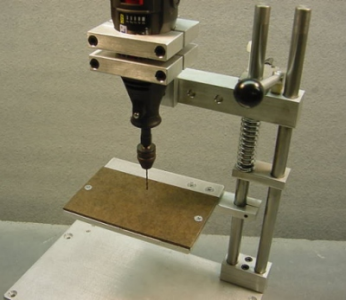
Vanda-Lay's top-of-the line drill press/mill/lathe/saw setups:
Mill:
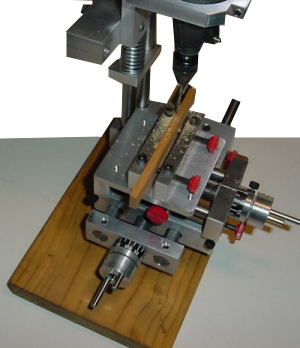
Lathe:
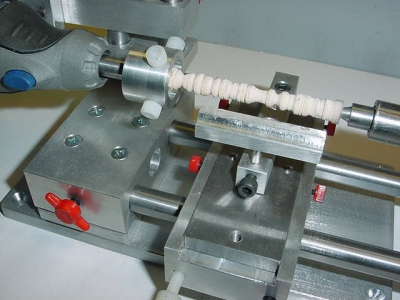
Saw:
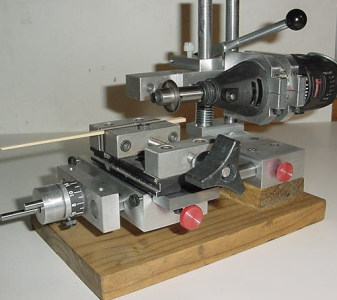
As Roger also wisely said, "Larger is better." when it comes to drill presses, but, as explained above, if you are intending to do miniature drilling and you don't want to break a bit every other hole, for the fine hole drilling you will be doing on models, you will want a very accurate drill press which does probably mean a smaller one. If you want a drill press to do general wood and metal drilling, remember that what you can drill with it will be limited by its capacity between the chuck and the table.
For larger general drill press work, larger is definitely better. If you are on a budget, you are in luck because drill presses are a dime a dozen on the used market. Buying a used top-of-the-line stationary power tool in decent shape is always the best way to go and there are lots of them out there, sometimes even at "get them out of my garage for free" prices! Look for "old 'arn" as it's called. 1950's era Craftsman tools, which were made by the top manufacturers of the time, early Delta tools (before they were bought out and their good name prostituted to sell crap,) Walker-Turner, King Seeley, and Atlas Press, are all excellent machines that will outlast our grandchildren. You can get by with a present day inexpensive Asian make, such as Ryobi or even the Big Box store house brands, but for the same price or probably less, you can have a drill press that's more powerful and more accurate than anything you can buy new today.
One example is the Craftsman benchtop drill press my dad bought in 1950 and gave to me when he was too old to use it any longer. It's made by King-Seeley and it's one humongous hunk of cast iron and machined steel. It even has a threaded collet holder that mounts on the spindle so it can be properly used as a milling machine. I got an X-Y table for it, and I use it for light milling jobs. (Good luck finding one of those threaded collect holder accessories these days, though!) I've seen these go on the local neighborhood online "for sale" sites for anywhere between $50 USD and $500 USD, depending on condition. The higher priced ones have been restored to like new condition, of course. They are now increasingly in demand by those in the know. The accuracy of any stationary power tool is dependent upon its mass. The inherent accuracy of the "old 'arn" machines cannot be duplicated by the stamped sheet metal and cast aluminum modern machines.
Craftsman benchtop drill press:
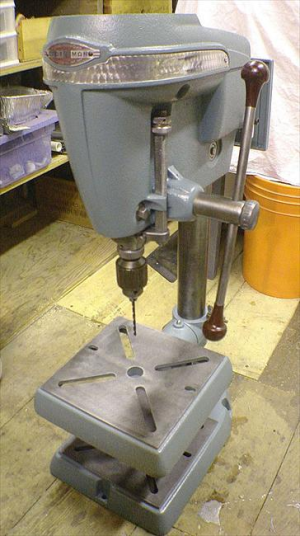
If I were in your shoes and cost was an object, which I suppose it is for everybody but the billionaire class, I'd do the following:
1. Get a basic Foredom flex shaft machine with the two basic handpieces, one with the Jacobs chuck and the other with the collet chuck and assorted collets. Get the hanger stand for it that clamps to a workbench top.
2. Get the Vanda-Lay drill press with the table accessory and, if you can afford it, get their Acura-mill which incorporates the drill press. Have Vanda-Lay make a holder for the 1" diameter Foredom handpieces for you. Add accessories to your Vanda-Lay system as you feel the need. (They aren't that expensive, relatively speaking.)
With your Foredom flex shaft and the Vanda-Lay system, you will have all you need for accurate miniature work, at least until such time as you start wanting fancier equipment. The Foredom and Vanda-Lay stuff will last forever, though.
3. Get a basic full-size benchtop drill press, "old 'arn" if you can find it and the price is right or used modern stuff. Buy new if you must, but you should be able to find a decent modern one used for a lot less.
This set up should give you a very good suite of modeling shop equipment for openers for less than a thousand bucks if you shop around. It should serve you well while you're saving up for your Byrnes micro-table saw, disk sander, and thickness sander... but that's a story for another night!
Last edited:
I have this Proxxon drillstand which I completed with the coumpound table KT 70 for some simpler milling and it works most of the time for my hobby work. I also bought a minidrill from Innocraftsman, a reall small thing, but easy and quick to use and I'm very pleased with it. https://innocraftsman.com/products/mini-drilling-machineImmediately, I come up with Proxxon TBM‑115 Precision Bench Drill Press
View attachment 527606
A specialty micro drill press for highly precise work. Belt-driven, three-speed (1800/4700/8500 RPM) with precision collets down to 0.5 mm—perfect for drilling mast holes, tiny fittings, etc., at a higher price point (~$230 Amazon).
If you own one of the Proxxon rotary tools already, you may look for a stand drill: Proxxon 28600 Micromot Drill Stand MB 200. Then, you can attach a rotary tool and use it as a drill press.
View attachment 527607
- Joined
- Jul 11, 2023
- Messages
- 317
- Points
- 168

@Bob Cleek, I must say that Bob clearly summarized the issue and option. I indeed went thru the route of getting the Foredom flex shaft, paired with Vanda-Lay drill press. Both are really nice. Torque and speed control from the shaft and precision craftmanship from Vanda-Lay. Highly recommend both. It won't replace quality dedicate system, but they will come at a far higher price for good built and precision. Remember, most are way too industrial for model crafting.
STICK with Foredom for all flex shaft accessories. The Chinese knock-off are just so bad. Got one before and the fit and build quality was exceptionally BAD... avoid, just avoid those.
STICK with Foredom for all flex shaft accessories. The Chinese knock-off are just so bad. Got one before and the fit and build quality was exceptionally BAD... avoid, just avoid those.
Just a thought to add:The Chinese knock-off are just so bad. Got one before and the fit and build quality was exceptionally BAD... avoid, just avoid those.
Not all products made in China are knock-offs or of poor quality. In fact, many well-known American brands are still manufactured in China. There are definitely some cheap tools out there (and yes, the quality can be terrible),
but the key difference is who is making it, not where it’s made.
So I’d say: caution is wise, but not everything “Made in China” deserves to be dismissed outright. Just my two cents...!




